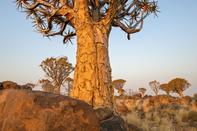Moving South
South Africa has seven distinct plant communities – desert, forest, fynbos, grassland, Nama-karoo, savanna and succulent karoo – and since their natural range reflects the climatic envelope of the biome, it made sense to use climate modelling to see how these might respond to rising temperatures.

In the late 1990s South African National Biodiversity Institute (SANBI) and the University of Cape Town climate scientists put the vegetation map of South Africa through some of their models and showed clearly that the natural biomes might shift to the south-east, with a significant drying sweeping down from the north-west of the country.
The most significant changes, they said, would probably happen to the succulent karoo biome while the Nama-karoo would shift eastward. When the SANBI scientists placed their quiver tree survey alongside the bio-climatic projections of the country’s climatic envelopes, they found the two mirrored each other perfectly.
The quiver trees were dying in the north, because conditions were becoming even hotter and drier in the desert, but were thriving in the south where conditions were still favourable. It looked as though the trees were “moving” south, in response to their shifting bioclimatic envelope. What makes the case more alarming, though, is that they appear to have been doing so for decades. The desert is pushing down towards the Cape.
By Leonie Joubert